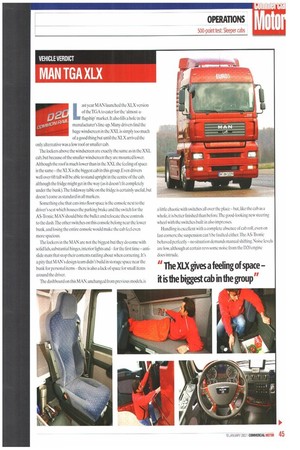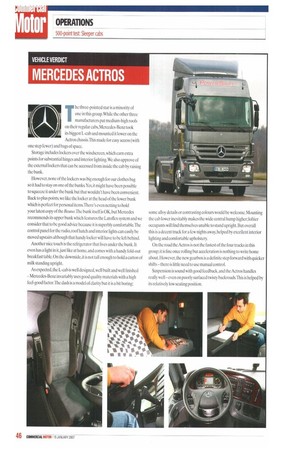ii the past we've brought you group tests of l)-frills
Page 43

Page 44

Page 45

Page 46

Page 47

If you've noticed an error in this article please click here to report it so we can fix it.
sleeper cabs and bells-and-whistles 11(!et flagships. But while you won't retain drivers with gaffer's motors, few fleet operators are going to pour their hard-won profits into top-of-the-range wagons So for this 500-point test we have gathered four trucks that are one step down from flagship status.
Mind you, that step is smaller than it used to be— not so many years back, all four contenders would have been classed as flagships:They feature comfortable bunks, clever gearboxes and steering wheels bursting with air bags and switches for a wide range of functions.Then there are electronic data displays. fridges and bags of storage space — though oddly enough, none of the manufacturers provided a truck with a USB connection for an MP3 player (which would have avoided the need to stash a library of CDs).
The test
As the na me implies. this 500-point test is half a 1000-point test in that we didn't take fuel measurements. Instead we focused on comfort and practicality:lb make the comparison as realistic as possible we put together a typical kit for a week away including clothes, food, books, bottles of drinks, oil and water. Having assessed each cab's storage options we turned our attention to han dling,suspension. comfort and noise levels.
OAF XF105
The latest Daf XF105 targets fleet operators with the Spacecab and the absence of the Super Spacecab with its conspicuous roof lights leaves this rig looking much like the previous version.
The interior is a different story; here everything is new. The 105 offers class-leading storage space and is the most practical cab in our group.The drawer next to the fridge was big enough to accommodate our clothes bag, immediately giving the Daf an advantage over the competition. In fact we could have brought twice as much kit and still been able to stash everything neatly away.
The excellent fold-out table introduced with the first Daf 95 lives on. the redesigned dash looks very 21st century and the cockpit is simply beautiful. It's almost sporty with plenty of aluminium and an attractive mix of digital and analogue instruments.
The bunks in the Daf arc still big and comfy. There is no high-tech Latoflex system,just a very thick and well designed mattress. Once settled down, the driver has a little storage space for personal effects. And still on the subject of storage, the lockers over the windscreen look a lot like those in the previous model but they have been fully redesigned everything is a hit rounder and some internal sharp edges are no more.
The under-bunk lockers can also be reached from the outside.They hold a lot of kit but external access is not too generous so big items must go through the cab. However this is no problem the Daf is the only cab in the group with two gas-filled dampers to hold the bunk out of the way.
On the road the Daf is exceptionally driver-friendly, even if the brake pedal takes a little getting used to.The parking brake and controls for the AS-Tronic transmission have migrated from the floor to the dash. This not only frees up some floor space, it also works better you don't really need these controls once you're on the move.
The gear changes are predictable and if you need to drop a cog the throttle kickdown does the trick.The suspension is on the hard side but many drivers may prefer that. Cab roll simply doesn't happen, so the driver gets a good feel for what's going on down below.
But no truck is perfect, which brings us to all-round vision.The new mirrors look smart and give a good rearward view but they block too much direct sight, especially on the nearside, as there's no way to look between the mirror housing and the A-pillar.
That aside, the 105 is a practical and comfortable vehicle that certainly won't harm your driver retention.
MAN TGA XLX
Last year MAN launched the XLX version of the TGA to cater for the 'almost-aflagship' market. It also fills a hole in the manufacturer's line-up. Many drivers find the huge windscreen in the XXL is simply too much of a good thing but until the XLX arrived the only alternative was a low roof or smaller cab.
The lockers above the windscreen are exactly the same as in the XXL cab, but because of the smaller windscreen they are mounted lower. Although the roof is much lower than in the XXL the feeling of space is the same— the XLX is the biggest cab in this group. Even drivers well over 6ft tall will be able to stand upright in the centre of the cab, although the fridge might get in the way (as it doesn't fit completely under the bunk).The foldaway table on the fridge is certainly useful, but doesn't come as standard in all markets.
Something else that eats into floor space is the console next to the driver's seat which houses the parking brake and the switch for the AS-Tronic.MAN should bite the bullet and relocate these controls to the dash.The other switches on this console belong near the lower bunk, and losing the entire console would make the cab feel even more spacious.
The lockers in the MAN are not the biggest but they do come with solid lids,substantial hinges, interior lights and—for the first time —antislide mats that stop their contents rattling about when cornering. It's a pity that MAN's design team didn't build in storage space near the bunk for personal items — there is also a lack of space for small items around the driver.
The dashboard on this MAN, unchanged from previous models. is a little chaotic with switches all over the place— but, like the cab as a whole, it is better finished than before.The good-looking new steering wheel with the switches built in also impresses.
Handling is excellent with a complete absence of cab roll, even on fast corners; the suspension can't be faulted either.The AS-Tronic behaved perfectly — no situation demands manual shifting. Noise levels are low, although at certain revs some noise from the D20 engine does intrude.
MERCEDES ACTROS
The three-pointed star is a minority of one in this group. While the other three manufacturers put medium-high roofs on their regular cabs.. Mercedes-Benz took its biggest L-cab and mounted it lower on the Actros chassis.This made for easy access (with one step fewer) and bags of space.
Storage includes lockers over the windscreen, which earn extra points for substantial hinges and interior lighting. We also approve of the external lockers that can be accessed from inside the cab by raising the bunk.
However, none of the lockers was big enough for our clothes bag so it had to stay on one of the bunks. Yes, it might have been possible to squeeze it under the bunk but that wouldn't have been convenient. Back to plus points, we like the locker at the head of the lower bunk which is perfect for personal items.There's even netting to hold your latest copy of the Beano. The bunk itself is OK, but Mercedes recommends its upper bunk which features the Latollex system and we consider that to be good advice because it is superbly comfortable.The control panel for the radio, roof hatch and interior lights can easily be moved upstairs although that handy locker will have to be left behind.
Another nice touch is the refrigerator that lives under the bunk. It even has a light in it,just like at home, and comes with a handy fold-out breakfast table. On the downside, it is not tall enough to hold a carton of milk standing upright.
As expected, the L-cab is well designed, well built and well finished — Mercedes-Benz invariably uses good quality materials with a high feel-good factor.The dash is a model of clarity but it is a bit boring; some alloy details or contrasting colours would be welcome. Mounting the cab lower inevitably makes the wide central hump higher; loftier occupants will find themselves unable to stand upright. But overall this is a decent truck for a few nights away, helped by excellent interior lighting and comfortable upholstery.
On the road the Actros is not the fastest of the four trucks in this group; it is fine once rolling but acceleration is nothing to write home about. However, the new gearbox is a definite step forward with quicker shifts — there is little need to use manual control.
Suspension is sound with good feedback, and the Actros handles really well— even on poorly surfaced twisty backroads.This is helped by its relatively low seating position.
VOLVO FH
The Volvo cab really is a beauty — aerodynamically rounded, not square and massive like the competition. Volvo offers an XL version on top of the Globetrotter although the difference is not great; it is still the smallest cab in the test group.
For a driver on his own it is comfortable enough but it does lack storage space. The lockers over the windscreen are not very deep and the space under the bunk can only be reached from the outside. However there are large external lockers with, you will be glad to hear, big doors.
In the middle of the cab is a drawer where a fridge can be installed; this incorporates a freezer, which inevitably reduces the capacity of the cooling compartment. Also, you need pretty long arms to reach it from the driver's seat.
Walnut veneers and aluminium aside, all modern vehicles have plastic dashboards —hut in the case of the Volvo it somehow looks too plasticky. The controls are OK but the symbols could be a bit bigger. And the overall design of the instruments could do with some attention; they are looking a little dated.
There is not a lot of storage space around the driver for personal items such as sunglasses or cigarettes. However, the version with the upper bunk features a step next to the driver's seat and this incorporates a storage compartment.The platform on the middle of the dash could easily be made twice as big; presumably this is some sort of Swedish safety precaution.
Out on the road the Volvo cab is still the most 'lively' of the four. Volvo has improved the cab suspension and front axle stabiliser but there is still some cab roll in fast corners — which at least warns the driver that his cornering is a bit too enthusiastic.The good news is that the suspension is fine: previous Volvos were a bit too hard but that has been corrected.
The behaved well on the poor surface section of our test track and the 1-Shift transmission works beautifully. Every time 1 reached for the 1-Shift lever to shift manually the system beat me to it.
But one niggle that Volvo has yet to cure is the big blind spot caused by the enormous mirror housings. On roundabouts the driver really has to lean forward out of the seat to check there is no traffic in the blind spot. Which, when you come to think of it, is a bit odd for a brand that has safety as its middle name.






















































































































































































